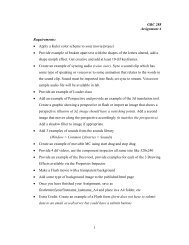Introducing Financial Accounting - CCSN Computer Graphics Program
Introducing Financial Accounting - CCSN Computer Graphics Program
Introducing Financial Accounting - CCSN Computer Graphics Program
Create successful ePaper yourself
Turn your PDF publications into a flip-book with our unique Google optimized e-Paper software.
wiL27041_ch01_002-047.indd Page 30 10/4/10 7:12:51 PM user-f499 /Volumes/204/MHBR211/wiL27041_disk1of1/0073527041/wiL27041_pagefiles<br />
30 Chapter 1 <strong>Introducing</strong> <strong>Financial</strong> <strong>Accounting</strong><br />
5. Geek Squad performs services for a customer and bills the<br />
customer for $500. How would Geek Squad record this<br />
transaction?<br />
a. Accounts receivable increase by $500; revenues increase<br />
by $500.<br />
b. Cash increases by $500; revenues increase by $500.<br />
A(B) Superscript letter A (B) denotes assignments based on Appendix 1A (1B).<br />
Icon denotes assignments that involve decision making.<br />
Discussion Questions<br />
1. What is the purpose of accounting in society?<br />
2. Technology is increasingly used to process accounting data.<br />
Why then must we study and understand accounting?<br />
3. Identify four kinds of external users and describe how they<br />
use accounting information.<br />
4. What are at least three questions business owners and<br />
managers might be able to answer by looking at accounting<br />
information?<br />
5. Identify three actual businesses that offer services and three<br />
actual businesses that offer products.<br />
6. Describe the internal role of accounting for organizations.<br />
7. Identify three types of services typically offered by accounting<br />
professionals.<br />
8. What type of accounting information might be useful to<br />
the marketing managers of a business?<br />
9. Why is accounting described as a service activity?<br />
10. What are some accounting-related professions?<br />
11. How do ethics rules affect auditors’ choice of clients?<br />
12. What work do tax accounting professionals perform in addition<br />
to preparing tax returns?<br />
13. What does the concept of objectivity imply for information<br />
reported in financial statements? Why?<br />
14. A business reports its own office stationery on the balance<br />
sheet at its $400 cost, although it cannot be sold for more than<br />
$10 as scrap paper. Which accounting principle and/or assumption<br />
justifies this treatment?<br />
15. Why is the revenue recognition principle needed? What does it<br />
demand?<br />
16. Describe the three basic forms of business organization and<br />
their key attributes.<br />
17. Define ( a) assets, (b) liabilities, (c) equity, and (d) net assets.<br />
QUICK STUDY<br />
QS 1-1<br />
Identifying accounting terms C1<br />
Quick Study exercises give readers a<br />
brief test of key elements.<br />
c. Accounts receivable increase by $500; revenues decrease<br />
by $500.<br />
d. Accounts receivable increase by $500; accounts payable<br />
increase by $500.<br />
e. Accounts payable increase by $500; revenues increase by<br />
$500.<br />
18. What events or transactions change equity?<br />
19. Identify the two main categories of accounting principles.<br />
20. What do accountants mean by the term revenue?<br />
21. Define net income and explain its computation.<br />
22. Identify the four basic financial statements of a business.<br />
23. What information is reported in an income statement?<br />
24. Give two examples of expenses a business might incur.<br />
25. What is the purpose of the statement of retained earnings?<br />
26. What information is reported in a balance sheet?<br />
27. The statement of cash flows reports on what major activities?<br />
28. Define and explain return on assets.<br />
29. A Define return and risk. Discuss the trade-off between<br />
them.<br />
30. B Describe the three major business activities in organizations.<br />
31. B Explain why investing (assets) and financing (liabilities and<br />
equity) totals are always equal.<br />
32. Refer to the financial statements of Research In<br />
Motion in Appendix A near the end of the book. To RIM<br />
what level of significance are dollar amounts rounded? What<br />
time period does its income statement cover?<br />
33. Identify the dollar amounts of Apple’s 2009 assets,<br />
Apple<br />
liabilities, and equity as reported in its statements in<br />
Appendix A near the end of the book.<br />
34. Refer to Nokia’s balance sheet in Appendix A<br />
near the end of the book. Confirm that its total<br />
assets equal its total liabilities plus total equity.<br />
35. Access the SEC EDGAR database (www.sec.<br />
Palm<br />
gov) and retrieve Palm’s 2009 10-K (filed July 24,<br />
2009; ticker PALM). Identify its auditor. What responsibility<br />
does its independent auditor claim regarding Palm’s financial<br />
statements?<br />
Connect reproduces assignments online, in static or algorithmic mode,<br />
which allows instructors to monitor, promote, and assess student<br />
learning. It can be used for practice, homework, or exams.<br />
Reading and interpreting accounting reports requires some knowledge of accounting terminology.<br />
(a) Identify the meaning of these accounting-related acronyms: GAAP, SEC, FASB, IASB and IFRS.<br />
(b) Briefly explain the importance of the knowledge base or organization that is referred to for each of the<br />
accounting-related acronyms.









